
The Gospel of Thomas and the Earliest Texts of the Synoptic Gospels
Neller K.V.
Год :1983 Количество страниц :351 [367] Язык :Английский Категория :Исследования Скачать : PdfПоддержать :
Research on the Gospel of Thomas in the last quarter of a century has made it clear that the origins of this apocryphal gospel cannot be satisfactorily explained from a single point of view. The author thus suggests that Thomas be understood as a growing collection of sayings which originated in various places and languages, with some logia being added to the collection after its inception. While this suggestion is by no means new, there have been few extensive attempts to study Thomas from such a presupposition. Due to the need for a control group, only the logia which have rather close parallels to the Synoptic gospels are investigated. Verbal and textual affinities are noted between these logia and the earliest texts of the Gospels (the Coptic versions, the Diatessaron, the Old Syriac version, and other early versions and Christian writings). Various degrees of probable contact between each logion and these texts are assigned. The results of this study give some idea as to the place of origin, the original language, and the approximate date at which certain logia were added to the collection. Those sayings which show a closer affinity to the Diatessaron, the Old Syriac version, or other Syrian writings may be considered as having been added to the sayings collection as it circulated in its earliest form, possibly in a Semitic language. Other logia which show no signs of awareness of a Syrian reading, but which are similar to variants found in the Coptic versions or other Egyptian texts, may well have originated in Egypt and been added to the collection at a later stage. These results, however, must await verification by those who might approach Thomas from related, but different, perspectives.





